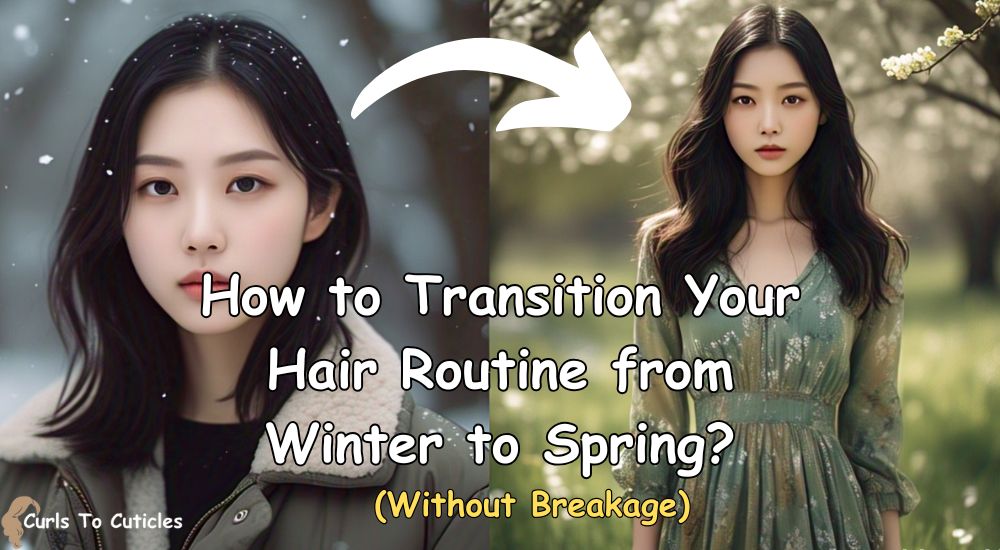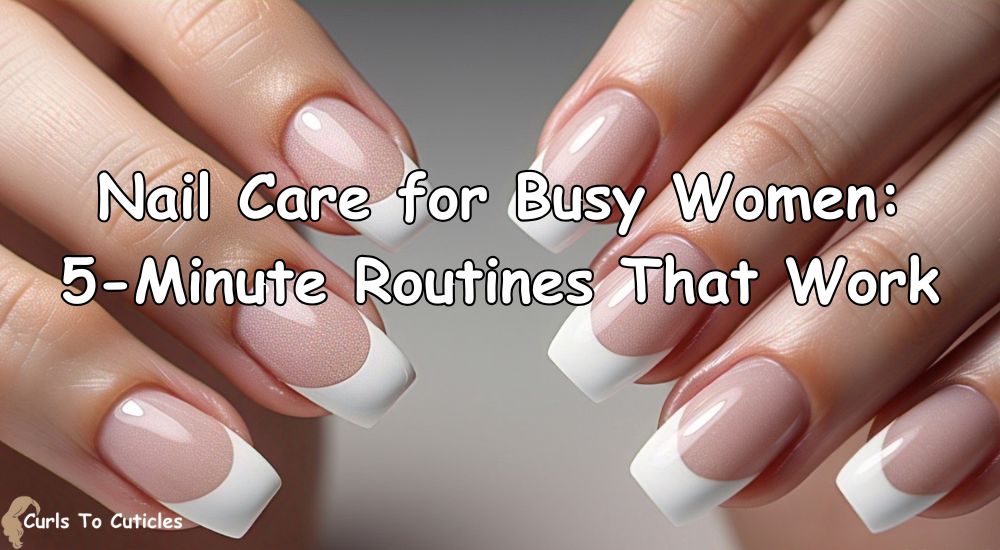Now Reading: How to Transition Your Hair Routine from Winter to Spring? (Without Breakage)
-
01
How to Transition Your Hair Routine from Winter to Spring? (Without Breakage)
How to Transition Your Hair Routine from Winter to Spring? (Without Breakage)

As seasons change, my hair care routine needs to change too. Winter often leaves my hair dry, brittle, and prone to breakage. When spring arrives, the air becomes warmer and more humid. My hair starts to react differently, and I must adjust my routine to match these new conditions. In this article, I will walk you through how I successfully shift my hair care routine from winter to spring without causing breakage or damage.

Understand How Winter Affects Hair
Winter makes the air dry. This dry air pulls moisture out of my hair. The cold weather also weakens the hair strands. I wear hats and scarves more often, which causes friction. This friction leads to split ends and breakage. During winter, I focus on moisture and protection. But as spring comes, I need to adapt.
Recognize Spring’s Impact on Hair
Spring brings warmer temperatures and higher humidity. My hair begins to absorb more moisture from the air. This can cause frizz and make my hair harder to manage. Also, my scalp may become oilier in spring. If I don’t adjust my routine, I may notice buildup, dryness at the ends, and increased breakage.
Step 1: Reduce Heavy Products
In winter, I use thick creams and oils to lock in moisture. These products protect my hair from dry air. But in spring, these heavy products weigh my hair down. They also mix with sweat and oil, creating buildup.
I switch to lighter products. I use leave-in conditioners with a water base. I also choose lighter oils like argan oil or jojoba oil. These still protect my hair but allow it to breathe. This step helps prevent clogged pores and scalp irritation.
Step 2: Increase Wash Frequency
I wash my hair less often in winter because it stays drier. But in spring, my scalp produces more oil. I sweat more too. If I continue my winter wash schedule, I notice buildup and odor.
So, I wash my hair more frequently in spring. I find a balance that works for me. For example, I wash my hair every three to four days instead of once a week. I use a gentle, sulfate-free shampoo to avoid drying out my strands. This keeps my scalp clean and helps prevent breakage.
Step 3: Use Clarifying Shampoo Once a Month
As I transition to spring, product buildup can become a problem. My scalp gets clogged, and my hair feels heavy. To fix this, I use a clarifying shampoo once a month. This removes leftover oils, styling products, and dirt.
I don’t overuse clarifying shampoo. If I use it too often, it strips my hair of its natural oils. I follow up with a deep conditioner to restore moisture. This helps my hair stay soft and healthy during the transition.
Step 4: Hydrate with Lightweight Moisturizers
Spring weather increases humidity, but that doesn’t mean I skip moisturizing. I still need to keep my hair hydrated. I just use lighter products.
I like aloe vera-based sprays or hydrating mists. These moisturize without leaving residue. I apply them daily or as needed. If my hair feels dry or looks dull, I refresh it with a light mist. This prevents dryness and reduces the risk of breakage.
Step 5: Trim the Ends
Winter can cause split ends and weak strands. If I don’t trim my ends, the damage spreads up the shaft. That leads to more breakage.
At the start of spring, I get a trim. I remove dead ends and give my hair a fresh start. Even a small trim helps improve hair health. My hair feels lighter and grows more evenly. Regular trims keep my hair strong through every season.
Step 6: Protect Hair from the Sun
Spring brings more sunshine. While sunshine feels good, UV rays can damage my hair. They dry out strands and fade color-treated hair.
I protect my hair by wearing hats or scarves when I’m outside for long periods. I also use hair products with UV protection. These products form a barrier between my hair and the sun. This prevents dryness and helps my hair stay healthy.
Step 7: Adjust Styling Tools
In winter, I often use heat tools like flat irons and curling wands. These help manage static and frizz caused by dry air. But in spring, humidity makes heat styling less effective and more damaging.
I reduce my use of heat tools in spring. I try air-drying when I can. I use heat-free styles like braids, twists, or buns. When I do use heat, I always apply a heat protectant spray. This limits damage and keeps my hair strong.
Step 8: Watch for Frizz and Tame It Gently
Humidity in spring causes frizz. My hair gets puffy and hard to control. I avoid heavy gels and waxes because they cause buildup.
Instead, I use light serums or creams with anti-frizz properties. I smooth them over my hair when it’s damp. I avoid brushing dry hair because that creates more frizz. I use a wide-tooth comb or my fingers. This keeps my strands intact and reduces breakage.
Step 9: Balance Protein and Moisture
Winter care usually focuses on moisture. But in spring, my hair may need more protein. Protein helps strengthen hair and reduce breakage. Too much protein, though, makes hair stiff and brittle.
I use a light protein treatment once a month. I also read product labels to see if they contain protein. I make sure to follow protein treatments with a moisturizing conditioner. This keeps the right balance for soft and strong hair.
Step 10: Use a Silk or Satin Pillowcase
Friction causes breakage. Cotton pillowcases absorb moisture and pull at my hair while I sleep. This is true in all seasons.
I use a silk or satin pillowcase to protect my hair. It helps my hair glide smoothly while I sleep. My styles last longer, and I wake up with less frizz. I also use a satin bonnet or scarf for extra protection.
Step 11: Stay Hydrated and Eat Well
Healthy hair starts from within. In winter, I sometimes drink less water. But in spring, I make an effort to stay hydrated. I drink more water throughout the day.
I also eat foods that support hair health. I choose foods with vitamins A, C, D, E, and B-complex. I include protein and healthy fats too. These nutrients support strong hair and help reduce breakage.
Step 12: Watch the Weather and Adjust
Spring weather changes often. Some days are warm and humid. Other days are cool and windy. I stay aware of the weather and adjust my routine as needed.
If it’s a rainy day, I avoid styles that don’t hold well in humidity. If it’s dry and windy, I add a little extra moisture to my hair. Staying flexible helps me prevent damage and keep my hair looking good.
Step 13: Clean Hair Accessories
Hair accessories collect oil, dirt, and product. If I reuse them without cleaning, they transfer buildup back to my hair.
I clean my brushes, combs, and clips regularly. I soak them in warm soapy water, rinse them well, and let them dry. Clean tools help keep my scalp healthy and reduce breakage.
Step 14: Avoid Tight Styles
Tight hairstyles pull on my roots and edges. Over time, they cause tension and lead to breakage or thinning.
In spring, I switch to looser styles. I choose low buns, soft braids, or loose ponytails. These styles give my hair room to breathe. They also reduce stress on my scalp and help me keep my hair strong.
Step 15: Monitor Scalp Health
My scalp can become oily or itchy in spring. If I ignore it, flakes and irritation follow. A healthy scalp supports healthy hair.
I check my scalp often. If I see flakes or feel itchiness, I use a gentle scalp scrub or a tea tree oil shampoo. This clears buildup and soothes irritation. A clean scalp keeps my hair growing well and reduces the chance of breakage.
Step 16: Use a Weekly Deep Conditioner
Even in spring, I keep deep conditioning in my routine. I use a light formula once a week. I apply it from root to tip, leave it on for 20 to 30 minutes, then rinse it out.
This helps restore moisture and smoothness. It also protects my hair from sudden weather changes. A regular deep conditioning habit keeps my hair healthy through the season.
Step 17: Keep a Simple Routine
Too many products or steps confuse my hair. I focus on a simple, consistent routine. I pick a few products that work and stick to them.
This helps me notice what works and what doesn’t. It also saves time and prevents buildup. A simple routine reduces stress on my hair and helps avoid breakage.
Step 18: Listen to Your Hair
My hair changes with time, weather, and even my diet. I pay attention to how it feels and looks. If it feels dry, I add more moisture. If it feels limp, I use less product.
By listening to my hair, I can respond early to problems. This helps me prevent damage before it happens.
Final Thoughts
Transitioning my hair care routine from winter to spring takes awareness and small adjustments. I reduce heavy products, increase moisture the right way, and keep my scalp clean. I trim dead ends, protect my hair from the sun, and avoid tight styles. I listen to what my hair needs and respond with care.
These steps help me protect my hair during the seasonal shift. I avoid breakage and keep my hair strong, soft, and manageable. With the right approach, spring becomes a time of healthy growth and fresh starts for my hair.







